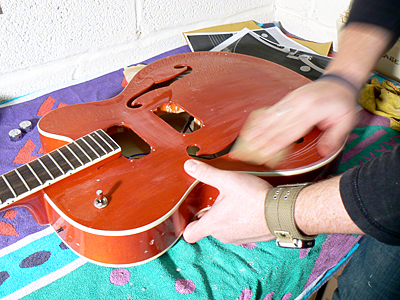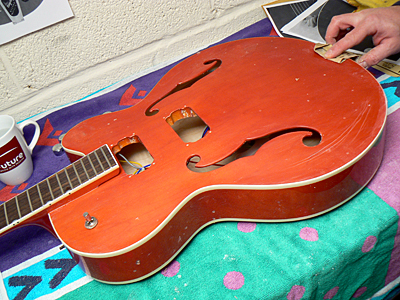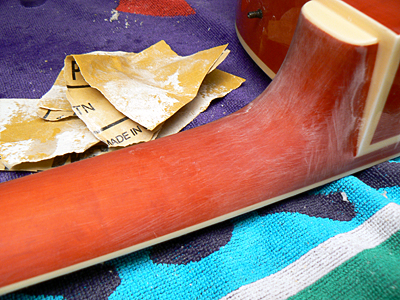How To Customise A Gretsch: The Third Step
It´s now impossible to put off the first of many irreversible steps any longer, so it´s out with the sandpaper to begin the unenviable task of removing the guitar´s polyurethane lacquer.
I discovered that finding the right grade of paper was a bit trial and error, but I suggest beginning with a finer grade and working upwards rather than vice versa: you can´t replace any dust you may wish you hadn´t removed after that first excited swipe with a piece of 40 Grade.
I gingerly began with a rather too fine 220 grade and after ten minutes of elbow grease, upped the paper to a more sensible 100. The idea here is to get down to the orange finish all over the body before setting about the various areas I want to get down to the bare wood with various implements.

So, the sanding. It did take far longer than I thought and I was careful to use a vertical rather than circular motion to ensure that no unsightly swirls had even a small chance of making it onto the finished guitar.

Also, a great tip is to wet the paper with water. This allows the paper to remain largely clog free and it also keeps the level of dust to a minimum. The only downside is that I found the paper didn´t last anywhere near as long as it did when used dry, but as sandpaper hardly breaks the bank, I couldn´t be overly concerned.
I began to sand the neck down too, which has already led to a super-smooth finish, although I am going to apply some heavier wear to this area in due course.

Finally for this step, I dug out a sturdy blade and began to mark off the areas that I wanted to get down to the bare wood. Again, this takes longer than you may think, but it´s all starting to look rather good.
Next step is to finish the body, the faux aging, the application of the decal and ultimately address the staining. Give me a couple of weeks...!
Want all the hottest music and gear news, reviews, deals, features and more, direct to your inbox? Sign up here.
Simon Bradley is a guitar and especially rock guitar expert who worked for Guitarist magazine and has in the past contributed to world-leading music and guitar titles like MusicRadar (obviously), Guitarist, Guitar World and Louder. What he doesn't know about Brian May's playing and, especially, the Red Special, isn't worth knowing.